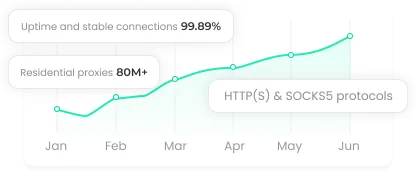How to Locate Your Proxy Address for Better Security
Whether you want smoother browsing, access to geo-blocked content, or enhanced security, understanding where and how to check your proxy is the first step. If you’ve ever asked yourself, “How do I find my proxy server address?”, this guide has you covered—across browsers, computers, and mobile devices. Plus, we’ll touch on proxy types, AI proxy usage, and tools like web proxy server.

What Exactly Is a Proxy Server
Think of a proxy server as a middleman between your device and the internet. The proxy address it gives you is the IP that routes your requests, masks your identity, and controls your connection. When users ask, "What is a proxy address?", this is exactly what they mean—the unique IP through which your traffic flows.
Why You Need a Proxy Server
Proxies are more than tech toys—they're tools for freedom, security, and efficiency online. Here's why people rely on them:
Access geo-blocked content: Watch, browse, or interact from regions normally restricted.
Boost security: Hide your IP and protect sensitive data from prying eyes.
Distribute traffic: Spread requests across multiple proxies for speed and anonymity.
A trusted proxy provider makes managing your proxy service list effortless. And if you're ever unsure, simply checking "what is my proxy?" confirms your traffic is routing correctly.
How to Locate a Proxy Server Address in Browsers
Here's the fast track for major browsers:
Chrome / Edge: Settings → System → Open your computer's proxy settings. Your proxy address lives here.
Firefox: Preferences → Network Settings → View your proxy address.
Safari: System Preferences → Network → Proxies → Check the details.
Knowing this helps troubleshoot connection issues or configure services like web proxy server quickly.
How to Locate a Proxy Server Address on Mobile
Even on phones, checking your proxy is straightforward:
Android: Wi-Fi → Modify Network → Advanced Options → Proxy. Your current address appears here.
iOS: Wi-Fi → Tap (i) → Configure Proxy → View proxy server address.
How to Locate a Proxy Server Address on Computers
Desktop instructions differ slightly by OS:
Windows: Control Panel → Internet Options → Connections → LAN Settings → Proxy server address.
macOS: System Preferences → Network → Advanced → Proxies → Check your proxy.
How to Locate a Proxy Address for Wi-Fi
Wi-Fi connections can have independent proxy settings. Verifying these ensures that every connection, from browsers to apps, runs through the right server. This step is critical for smooth operation with tools like web proxy or when managing a full proxy service list.
The Proxies of AI
AI tools—like Jan AI—rely on specialized proxies to maintain access and avoid detection. Key types include:
Residential Proxies: IPs from real users, mimicking natural browsing patterns. Perfect for scraping or automation without getting flagged.
Datacenter Proxies: Fast, efficient, and ideal for high-volume requests.
Rotating Proxies: Change IPs automatically with each request, keeping AI tools uninterrupted.
Understanding and using rotating proxies across locations ensures AI systems run smoothly while avoiding bans. If you've ever wondered, "How does Jan AI manage proxies?", this is the secret sauce.
Conclusion
By 2025, finding your proxy address isn't just technical—it's strategic. Whether on browsers, computers, or mobile, knowing where to look keeps your connections private and reliable. Pair that knowledge with a trusted proxy provider and an updated service list, and you'll have seamless access, enhanced security, and control over your digital footprint.


















































